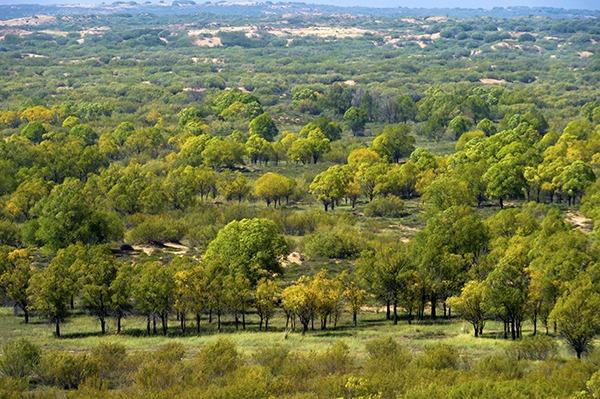 This undated file photo shows restored desertified land. Over 133,000 hectares of desertified land in Yanchi has been restored. (PHOTO / FORESTRY.GOV.CN / CHINA DAILY)
This undated file photo shows restored desertified land. Over 133,000 hectares of desertified land in Yanchi has been restored. (PHOTO / FORESTRY.GOV.CN / CHINA DAILY)
YINCHUAN-Every autumn in the 1980s, Huang Zhong's farmland in the Ningxia Hui autonomous region was blanketed with heavy layers of sand blown in by strong winds.
Over the past 42 years, over 7.88 million hectares of windbreak trees have been planted, 336,000 square kilometers of desertified land managed, and more than 10 million hectares of grassland protected and restored, according to a report released by the National Forestry and Grassland Administration
"A severe sandstorm could bury mud huts overnight in the village, and sand dunes were scattered everywhere," the 56-year-old recalled.
His home village of Liuyangpu in Yanchi county is on the southern edge of the Muus Sandland. Four decades ago, the harsh climate, a prolonged drought and overgrazing left about 75 percent of the village population stranded as desert encroached into the area, according to statistics from the county government.
Life was difficult for Huang growing up. Following poor harvests, his family survived on millet and buckwheat grown on their farmland.
"We didn't even have grass to graze our sheep," he said, adding that back then they had to migrate to cities to earn a living.
But not anymore. Now the sand and dunes are gone, replaced by lush greenery, including stands of trees and plants used in traditional Chinese medicine, thanks to a project to prevent desertification and soil erosion.
In 1978, China launched the Three-North Shelterbelt Forest Program. The afforestation project covers 13 provincial-level regions in the northwest, north and northeast and equates to 42.4 percent of the country's total land area. The program will be implemented in eight phases and is expected to be completed by 2050.
Over the past 42 years, over 7.88 million hectares of windbreak trees have been planted, 336,000 square kilometers of desertified land managed, and more than 10 million hectares of grassland protected and restored, according to a report released by the National Forestry and Grassland Administration.
Forest coverage has grown to 13.57 percent from 5.05 percent in 1977.
ALSO READ: After centuries of waste, quota system helps Ningxia save water
As one of the key areas under the project, Yanchi started a large-scale environmental restoration project in the 1990s to minimize the impact of sand blown into the county.
In 2002, local authorities prohibited grazing and villagers said farewell to their traditional herding lifestyle.
Mats made of straw were weaved to contain the moving sand dunes, and drought-resistant shrubs and grasses were grown.
Over 133,000 hectares of desertified land in Yanchi has been restored, and large sand dunes have virtually disappeared.
In addition to improving the environment, the project has given impetus to poverty alleviation efforts.
"The program has effectively curbed the expansion of desertification and become a 'Green Great Wall' to protect areas from sandstorms, preserve water and soil and safeguard agriculture, laying a solid foundation for poverty alleviation," said Yue Taiqing, deputy director of the TSFP construction bureau of the National Forestry and Grassland Administration.
Yue added that nowadays, more and more environmental resources in northern China are being transformed, using ecotourism, forestry and other means to lift people out of poverty. Some people have also taken up roles as forest rangers to do afforestation and forest management work.
READ MORE: China's eco-reform aids green initiative
In 2016, with the help of the TSFP, Huang and more than 1,100 villagers from registered poverty-stricken households were recruited as forest rangers, with each earning an annual income of over 10,000 yuan (US$1,460).
Huang and his wife also planted seedlings used in traditional Chinese medicine, which have earned them additional income of more than 30,000 yuan over the past year.
"As forest rangers, we don't have too much pressure now because villagers make efforts to plant trees, and they are aware of the importance of forest protection," Huang said.
In 2018, Yanchi became the first of nine counties in Xihaigu, an area in Ningxia known for its poor living conditions, to escape poverty. Yue said afforestation has been fueling China's poverty alleviation efforts.


